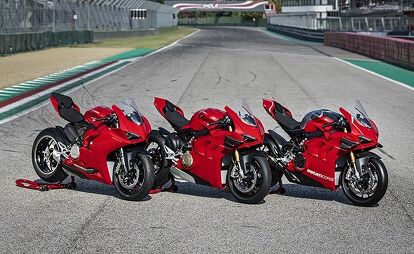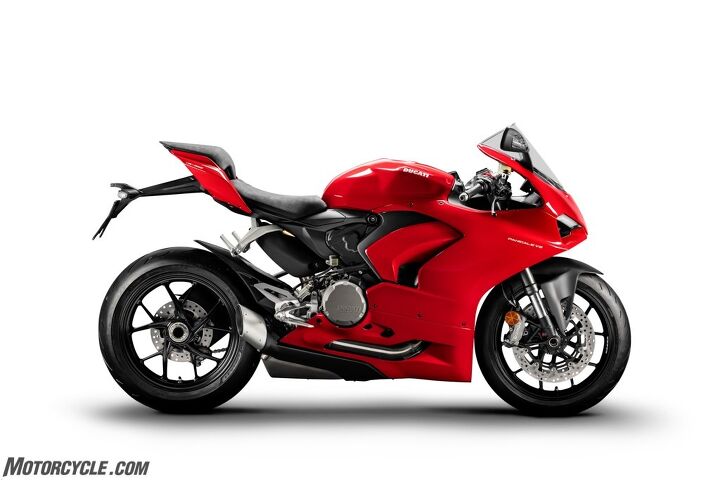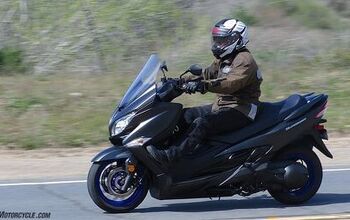Ducati Updates Panigale Family For 2020, Including The New Panigale V2

Lost in the buzz Ducati’s Panigale V4 stirred since its introduction was the fact its baby brother, the 959 Panigale, had remained untouched. Squashing any concern that the model was going away (at least for now), Ducati today announced the Panigale V2 – the new name for the 959 Panigale – featuring updates and technology from its V4 sibling. While they were at it, the V4 family received some updates too, which we’ll get to later.
The new and improved Panigale V2
The most obvious deviation for the Panigale V2 compared to the 959 Panigale is its revised appearance, clearly aimed to look more like its V4 counterparts. More than just slapping V4 bodywork on the V2 and calling it good, Ducati modeled the new bodywork to tightly hug the monocoque frame and narrower width of the Superquadro V-Twin, creating a slimmer, less intimidating profile than the V4 – an interesting move from the folks at Borgo Panigale in the hopes of attracting riders into the Panigale family who might not yet be ready for the full onslaught the V4s deliver. Moving to the rear of the motorcycle, the Panigale V2 again delivers a premium look over the 959 Panigale with its single-sided swingarm (the 959 had a more traditional, twin-spar swingarm). Showa Big Piston Fork (with slightly more travel) and Sachs shock handle bump absorption, and Pirelli Diablo Rosso Corsa II tires put power to the ground.
Speaking of power, Ducati has massaged the 955cc Superquadro V-Twin to produce five more horses and two more pound-feet than before – 155 hp @ 10,750 rpm and 77 lb-ft @ 9,000 rpm, respectively – all while being Euro 5 compliant. Revising the twin-spark layout had a part in this, as did tweaks in air-intake funneling and exhaust routing.
Helping the rider to harness that power, both on the street and the track is an electronics package anchored by a six-axis IMU, giving the rider cornering ABS, Ducati Traction Control EVO2, and wheelie control. The Panigale V2 now also features an up/down quickshifter and engine brake control. Optional accessories include the Ducati Lap Timer GPS, Ducati Multimedia System, and the Ducati Data Analyser+ GPS.
As usual, the three ride modes (Race, Sport, Street) incorporate the various rider aids, and the rider has the ability to adjust various settings via the new 4.3-inch TFT display.
U.S. pricing has been set at $16,495.
Panigale V4 Updates
For the Panigale V4 family, both the base and S models get a heavy influence from its V4 R sibling visually, mechanically, and electronically. This is most noticeable in its appearance, as both standard and S models now receive a very similar fairing design as the R – yes, that includes the winglets. The plexiglass screen is higher and more angled which, combined with the nose fairing that is also higher and wider (+15mm per side), make for a larger bubble for the rider and shields more of the shoulder and arms.
The side fairings are now 38mm wider per side, further shielding the rider from air, and the former S model vents are now replaced with the more efficient R model vents, providing 6% and 16% more airflow to the water and oil radiators, respectively. Also borrowed from the R model are the winglets. Designed before MotoGP placed restrictions on spoiler shapes, Ducati says the Panigale’s aerofoils are actually more efficient than the ones currently used on the GP16 MotoGP machine and can produce up to 30kg of downforce at 270 kph (167 mph).
Being the brutal tour-de-force that it is, the 1103cc V4 engine remains virtually unchanged mechanically, though its Ride by Wire mappings have been revised thanks to the massive amounts of feedback Ducati has received from race teams, international media, and customers alike. Torque delivery settings have been smoothed out (and are adjustable) to provide better relation between throttle, right wrist, and tire, while further linearization of the torque curve in the first three gears helps the rider better maintain stability and traction under acceleration.
A major change for the base and S models, and one I’m happy to see, is the use of the stiffer front subframe, similar to the R model except for its lighter, machined sides. One of the complaints I had with the previous S model was its lack of front-end feel, especially at high lean angles. This change should help remedy that, if the few laps aboard R models I’ve taken is any indication.
Beyond the front subframe, several chassis tweaks were also implemented to raise the center of gravity 5mm to provide quicker turn-in. In turn, the higher rear end also increases the chain force angle, resulting in more anti-squat, for more stability on acceleration.
U.S. pricing sees a $500 increase for both models, putting the standard V4 at $21,995 and V4 S at $28,395. We look forward to riding the new and improved Panigale lineup to see for ourselves what each bike is capable of.

Troy's been riding motorcycles and writing about them since 2006, getting his start at Rider Magazine. From there, he moved to Sport Rider Magazine before finally landing at Motorcycle.com in 2011. A lifelong gearhead who didn't fully immerse himself in motorcycles until his teenage years, Troy's interests have always been in technology, performance, and going fast. Naturally, racing was the perfect avenue to combine all three. Troy has been racing nearly as long as he's been riding and has competed at the AMA national level. He's also won multiple club races throughout the country, culminating in a Utah Sport Bike Association championship in 2011. He has been invited as a guest instructor for the Yamaha Champions Riding School, and when he's not out riding, he's either wrenching on bikes or watching MotoGP.
More by Troy Siahaan
























































































































































Comments
Join the conversation
I miss the Terblanche "double-cyclops" styling of the 999. This Panigale is too reminiscent of the ugly-duckling 916.
Judging from the single digit number of comments in the 6-ish days since posting, Panigales have lost some of their appeal. Too bad since these updates to both models are improvements (except the inevitable price hike). If you live in a paradise of fast twisty roads and also love the look of race replicas, but don't want to face the burden of restraining your right wrist to avoid felony speeding, the V2 might be the perfect option - all the track-day capability you will ever need yet you can still wring it out a bit on the street without going directly to jail. If you need to feel the POWER 24/7 but want a track optimized bike, then the V4 is your baby; just don't blame Ducati if it gets you in trouble. Of course if you like the racebike look but are really hoping to mellow out there's the Supersport, but hey, you know that's kind of a different thing.
All of which is to say these Panigales ARE the legacy of Ducati's years of racing; kind of the core DNA of the company - to my mind the V2 particularly so. If Ducati can't get people excited about these bikes then something is seriously wrong.